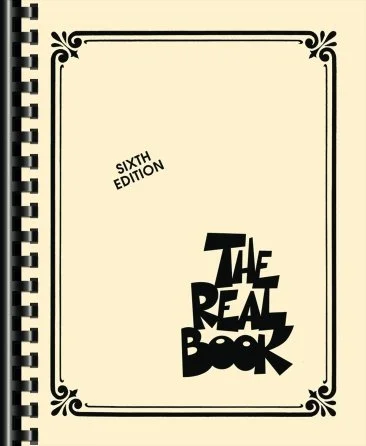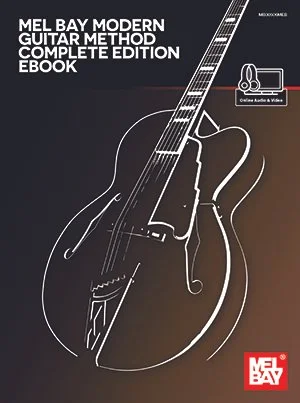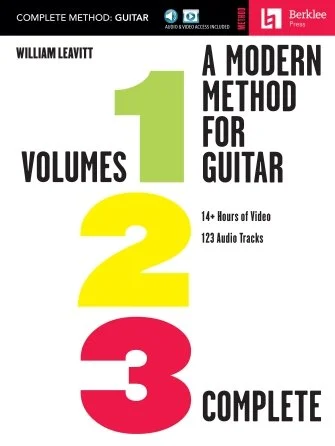These 5 Guitar Books Offer a Lifetime of Learning (You’ll Never Outgrow Them)
Some books are meant to be read once; others are meant to end up with coffee stains and torn pages after years of being read repeatedly. After years of studying myself and passing that knowledge on to hundreds of students, I’ve found that these books always end up in guitar players' libraries—and they stick around, getting returned to time and time again. Whether you're just starting out or have years with your guitar, these books are sure to bring something to the table and give you a stronger, more in-depth look at the instrument we all love. The clickable links in this post help support this blog through affiliate commissions—so thank you in advance to anyone who helps make content like this possible.
They're dense, deep, and bottomless—and I mean that in the best way possible.
The Guitar Grimoire: A Compendium of Formulas for Guitar Scales and Modes
To start us off, here is one of the most comprehensive books on scales and modes out there. Defined as a “grimoire”—which Merriam-Webster defines as a “magician's manual…”—think of this as a guitar player's spell book. Any scale you can conceive is guaranteed to be in this book, and it’s explained in very simplistic terms so that it appeals to every guitarist. No reading chops (TAB or musical notation) are needed for this book—everything is explained in diagram form. This makes it easier than ever to explore different sounds, understand the construction of scales, and develop a deeper understanding of the guitar so you can navigate it more easily and create beautiful sounds as you will.
As Ted Greene best puts it in the very first line of this legendary book, “This book deals primarily with chords and their application.” Ted Greene was a guitar player, educator, studio musician, and author of a handful of extremely helpful and informative books. If you have the funds, I recommend getting all of his material—as the cost versus the value is tenfold.
This book in particular is a valuable one because the guitar, being used primarily as a rhythmic, chordal instrument, benefits from this book much like a writer benefits from a dictionary. In combination with other resources (i.e., our next book), this is a great tool not only for learning chords but also for solidifying a deeper understanding of the fretboard.
In our last resource, we discussed learning chords and their applications. This book is definitely an application book.
What was originally known by the general term “Fake Book” started as an underground ring of musicians illegally copying and selling sheet music—long before the use of iPads, PDFs, and 2-day delivery. Named as a pun on that term by a group at Berklee who developed this collection of the most popular tunes kicking around at the time, it has grown to be one of the most widely used music books for musicians of any instrument.
With 400 songs, you’ll never run out of repertoire to learn and exercise your chord voicings, scales, improvisational, or arranging skills.
Modern Guitar Method Complete Edition Part 1 & Part 2
When learning guitar, there’s a lot of ground to cover: chords, scales, fretboard knowledge—to name just a few. Covering all of these from different sources can have its pros and cons, but it can sometimes feel scattered without some guidance.
This book is one of those Swiss Army knife-type resources, providing that guidance in a tight-knit package with PLENTY of repertoire and real-life applications along the way. It covers all things guitar in a comprehensive, well-paced manner that won’t leave you feeling overwhelmed.
Although there is no tablature included in this book, that’s a great excuse to begin exploring standard notation—especially since many resources out there are tab-free and may continue that way indefinitely.
Coming in at over 600+ pages, you’ll never see the second cover once you pass the first—and trust me, you’ll be glad you did.
A Modern Method for Guitar Complete Edition
Being a guitar player, you’re probably a John Mayer fan. Maybe not? How about Steve Vai? Al Di Meola? Maybe John Scofield or John Petrucci?
Now, what’s the common denominator between all these string slingers? They all went to Berklee College of Music—a capital for innovative and virtuosic guitar players. While all these riff makers were studying and developing their chops to soon become legends in the guitar community, they probably studied much of the material in this book—and if not, directly with the author, William Leavitt.
Leavitt was the chair of the guitar department at Berklee College of Music for over 20 years and was a lead developer of the curriculum still used to this day. He was an early attendee of the school and helped shape it into the legendary guitar education hotspot it has become.
Just like our previous book, this is another invaluable Swiss Army knife to give you an overarching education on the guitar—and it will leave you coming back time and time again to search through its 400+ pages.
These five books aren’t just resources—they’re an extension of your practice space. They’re the kind of books you keep right on your music stand or within arm’s reach. Whatever topic you find yourself diving into—chords, scales, improvisation, harmony, or arranging—you’ll always find the answers you’re looking for in these pages.
Is there a “bottomless” book you love that didn’t make the list? Feel free to drop it below—I’d love to hear about it.
And if you’re looking for guidance on how to work these into your practice routine or get the most out of them, you can always [book a lesson with me here.





